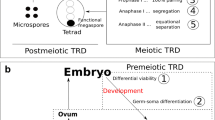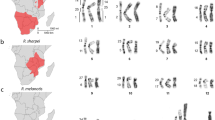Abstract
Karyotype comparisons of both parents and progeny from single pair matings in the grasshopper Myrmeleotettix maculatus have shown that there is an accumulation of the large mitotically stable B-chromosome when transmitted through the female. This is presumed to result from a preferential segregation of univalent B-chromosomes at the first division of female meiosis and occurs irrespective of whether the B's are odd or even in number. In the male there is a loss of B-chromosomes. This loss does not appear to be due simply to the lagging and elimination of B-chromosomes in meiosis but probably involves sperm formation or function. When the balance of the gain and loss after one generation is calculated, it shows large overall accumulation in crosses involving individuals from a population in Wales, and a slight loss in individuals from a population in East Anglia. Such differences in transmission rates may be responsible for differences in B-frequency between populations. Since the B-chromosome frequency of these two populations has remained stable over five years, possible forces in the maintenance of the equilibria are examined. Females with B-chromosomes produce more aneuploid embryos than 0B females, but neither this cause of inviability nor general embryo mortality seem sufficient to produce an equilibrium situation. It is necessary to postulate that progeny with more than 2B chromosomes are inviable in order to approach equilibria. The presence of B-chromosomes in females has also led to the formation of polyploid embryos. The possible involvement of repetitive DNA in the formation of unreduced egg nuclei and preferential segregation is discussed.
Similar content being viewed by others
References
Eckhardt, R. A., Gall, J. G.: Satellite DNA associated with the heterochromatin in Rhynchosciara. Chromosoma (Berl.) 32, 406–427 (1971).
Gibson, I., Hewitt, G. M.: Interpopulation variation in the satellite DNA from grasshoppers with B-chromosomes. Chromosoma (Berl.) 38, 121–138 (1972).
Hewitt, G. M.: The structure and role of B-chromosomes in the mottled grasshopper. Chromosomes today 3, 208–222 (1972).
Hewitt, G. M., Brown, F. M.: The B-chromosome system of Myrmeleotettix maculatus (Thunb.). V. A steep cline in East Anglia. Heredity 25, 363–371 (1970).
Hewitt, G. M., John, B.: The B-chromosome system of Myrmeleotettix maculatus (Thunb.). III. The Statistics. Chromosoma (Berl.) 21, 140–162 (1967).
Hewitt, G. M., John, B.: Inter-population sex chromosome polymorphism in the grasshopper Podisma pedestris. II. Population parameters. Chromosoma (Berl.) 37, 23–42 (1972).
Hewitt, G. M., Ruscoe, C. N. E.: Changes in micro-climate correlated with a cline for B-chromosomes in the grasshopper Myrmeleotettix maculatus (Thunb.) (Orthoptera:Acrididae). J. Anim. Ecol. 40, 753–765 (1971).
John, B., Hewitt, G. M.: The B-chromosome system of Myrmeleotettix maculatus (Thunb.). I. The mechanics. Chromosoma (Berl.) 16, 548–578 (1965 a).
John, B., Hewitt, G. M.: The B-chromosome system of Myrmeleotettix maculatus (Thunb.). II. The statics. Chromosoma (Berl.) 17, 121–138 (1965 b).
Kimura, M., Kayano, K.: The maintenance of supernumerary chromosomes in wild populations of Lilium callosum by preferential segregation. Genetics 46, 1699–1712 (1961).
Lewis, K. R., John, B.: Breakdown and restoration of chromosome stability following inbreeding in a locust. Chromosoma (Berl.) 10, 589–618 (1959).
Moens, P. B.: The fine structure of meiotic chromosome polarisation and pairing in Locusta migratoria spermatocytes. Chromosoma (Berl.) 28, 1–25 (1969).
Nur, U.: Mitotic instability leading to an accumulation of B-chromosomes in grasshoppers. Chromosoma (Berl.) 27, 1–19 (1969 a).
Nur, U.: Harmful B-chromosomes in a mealy bug: Additional evidence. Chromosoma (Berl.) 28, 280–297 (1969 b).
Pardue, M. L., Gall, J. G.: Chromosomal localisation of mouse satellite DNA. Science 168, 1356–1358 (1970).
Rothfels, K. H.: Chromosome complement, polyploidy and supernumeraries in Neopodismopsis abdominalis (Acrididae). J. Morph. 87, 287–316 (1950).
Sannomiya, M., Kayano, H.: Local variation and year-to-year change in frequencies of B-chromosomes in natural populations of some grasshopper species. Proc. 12th Intern. Congn. Genet. 2, 116–117 (1968).
Walker, P. M. B.: Origin of satellite DNA. Nature (Lond.) 229, 306–308 (1971).
Zimmering, S., Sandler, L., Nicolettie, B.: Mechanisms of meiotic drive. Ann. Rev. Genet. 4, 409–436 (1970).
Author information
Authors and Affiliations
Rights and permissions
About this article
Cite this article
Hewitt, G. Variable transmission rates of a B-chromosome in Myrmeleotettix maculatus (Thunb.) (Acrididae: Orthoptera). Chromosoma 40, 83–106 (1973). https://doi.org/10.1007/BF00319837
Received:
Issue Date:
DOI: https://doi.org/10.1007/BF00319837




